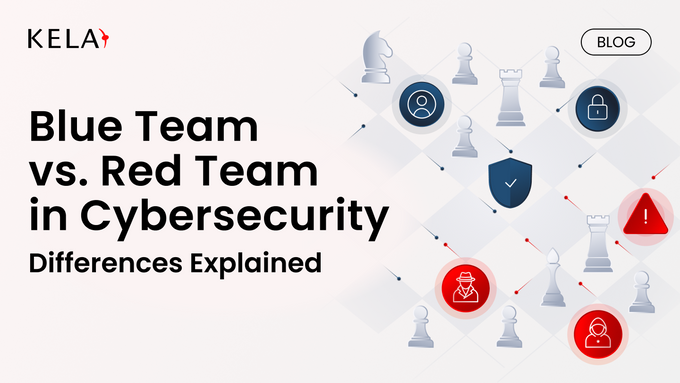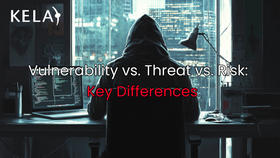Blue Team vs. Red Team in Cybersecurity: Differences Explained
Discover the roles of blue and red teams in cybersecurity and how their collaboration strengthens your defense strategy, helping to stay ahead of evolving threats.
Updated July 7, 2025

Cybersecurity is a dynamic field where different teams work together to outsmart potential attackers. Blue teams and red teams play crucial roles, each bringing a unique perspective to the table. Red teams simulate attacks, pushing defenses to their limits, while blue teams stay on the front lines, focused on protection and rapid response. Their collaboration and continuous improvement are essential in maintaining robust security.
By understanding how these teams operate and complement each other, organizations can strengthen their overall defense strategy against evolving and sophisticated threats. In this blog, we will explore the key differences between these teams and how their coordinated efforts enhance cybersecurity resilience.
» Ensure your cybersecurity is up to standard with KELA
What Are Red and Blue Teams in Cybersecurity?
Red team: A group that simulates real-world cyberattacks to uncover weaknesses in an organization’s systems and processes.
Blue team: A group responsible for defending those systems through monitoring, detection, and incident response.
Origins and Evolution
Red and blue teaming began in military wargames—red teams acted as adversaries to challenge the strategies of blue teams, who represented friendly forces. This adversarial setup was designed to test readiness and improve defense tactics.
Over time, the concept was adopted in cybersecurity, where red teams emulate threat actors and blue teams respond, detect, and adapt. Their structured opposition now forms the backbone of modern cyber defense strategies, enhanced further by purple teaming collaboration.
» Discover how KELA’s Threat Actors Hub can help you uncover your adversaries
Objectives of Red Teams and Blue Teams in Cybersecurity
Red Team Objectives (Offensive Role)
Red teams adopt an offensive approach by simulating real-world attackers. Their primary responsibility is adversary emulation, employing the tactics, techniques, and procedures (TTPs) used by actual threat actors. They aim to:
- Breach systems by exploiting vulnerabilities.
- Evade detection using realistic attack techniques.
- Achieve specific goals, such as gaining unauthorized access to sensitive data.
Blue Team Objectives (Defensive Role)
Blue teams take on a defensive role, focusing on safeguarding digital assets and strengthening organizational resilience. Their main objectives are:
- Monitoring systems and networks continuously to identify potential threats in real time.
- Implementing security controls that reduce vulnerabilities and limit exposure.
- Analyzing logs and events to detect suspicious or anomalous behavior.
- Responding to incidents effectively, whether simulated or real.
- Reinforcing defenses to prevent future breaches and improve overall preparedness.
» Worried about security? Here are the reasons you need cyber threat intelligence
How Purple Teaming Unifies Red and Blue Team Strategies
While red and blue teams play crucial roles independently, their efforts can be even more impactful when combined.
Purple teaming bridges the gap between offense and defense, creating a collaborative environment where both sides learn and improve together.
Benefits of Purple Teaming
- Faster improvement: The blue team quickly assesses whether they detected specific attack techniques (TTPs) used by the red team, analyzes the results, and adjusts detection rules and response playbooks in real-time.
- Enhanced context & understanding: Both teams gain valuable insights: the blue team comprehends the rationale behind alerts, while the red team learns about the defenses they encountered.
- Efficient validation: Security controls undergo collaborative testing against known TTPs, optimizing the efficiency of the testing process and improving defenses.
This collaborative feedback loop significantly reduces the time required to strengthen detection and response capabilities compared to isolated exercises.
Skills and Certifications Needed by Red Teams
Red team professionals adopt an offensive approach. They focus on exploitation, evasion, and scripting to simulate real-world attackers.
Certifications such as OSCP and GPEN often demonstrate their technical capabilities.
Key Traits
- Creativity: To think like an attacker and come up with unconventional paths.
- Persistence: To push through obstacles during complex simulations.
Technical Acuity
The red team needs profound technical understanding across diverse domains (networking, OS internals, web applications, cloud, protocols) to identify subtle vulnerabilities, chain exploits, bypass sophisticated controls, and often develop custom tools. Superficial knowledge isn't enough to emulate advanced persistent threats.
Curiosity in Practice
Curiosity drives system exploration (“How does this really work?”), boundary testing (“What happens if I do this?”), and persistence in finding hidden attack paths that scanners miss. It fuels creative thinking and the attacker mindset needed to uncover non-obvious weaknesses.
Skills and Certifications Needed by Blue Teams
They focus on monitoring, incident response, digital forensics, and using tools like Security Information and Event Management (SIEM) and Endpoint Detection and Response (EDR) effectively.
Certifications include GCIH, GCFA, and CySA+, each validating essential skills in incident handling, forensics, and security analysis for blue team roles.
Key Traits
- Analytical thinking: To assess and interpret complex security data.
- Attention to detail: To catch small indicators of compromise.
- Patience under pressure: To manage real-time incidents calmly.
Technical Acuity
Strong technical skills are essential for recognizing what’s normal in your environment and spotting anything unusual. This includes reading logs and alerts from tools like SIEM, EDR, and NDR, performing digital forensics, analyzing malware, and building strong defenses. Without this sharpness, it’s easy to overlook or misunderstand threats.
Curiosity in Practice
Curiosity pushes defenders to go beyond surface-level answers and ask deeper questions like, “Could an attacker bypass this control, and how?” or “Why did this alert trigger, and what’s the real cause?” This kind of thinking encourages proactive threat hunting, helps uncover hidden patterns, and leads to stronger incident analysis. It also fuels a constant desire to learn about new attack techniques and defensive strategies—keeping defenders sharp, prepared, and one step ahead.
Take note: While their goals differ—the shared foundation of technical skill and the drive to constantly ask "why?" and "how?" are essential for red and blue team effectiveness in the constantly evolving cybersecurity landscape.
» Make sure you understand the difference between vulnerability, threat, and risk to strengthen your cybersecurity strategy
Importance of Integrating Red Teams and Blue Teams Into Your Cybersecurity Strategy
Benefits of Regular Red Team Engagements
- Realistic vulnerability identification: Red teams identify intricate attack paths and exploitable weaknesses that automated tools often overlook. By simulating TTPs of real adversaries, they offer an accurate assessment of organizational risk that transcends basic scanning results.
- Validation of defenses: These engagements rigorously assess the effectiveness of existing security controls and monitoring tools, such as SIEM systems and EDR solutions. This process reveals actual performance gaps, ensuring that the blue team is prepared to detect and respond to sophisticated attacks.
- Targeted security improvement: The insights gained from red team findings provide concrete evidence that identifies where security investments are most needed. This information helps justify budgets, prioritize remediation efforts, and guide the effective tuning of defensive technologies against verified threats.
- Enhanced skill development: Exposing defenders to realistic and controlled attack scenarios delivers invaluable hands-on experience. This exposure significantly enhances their skills in detection, investigation, incident response, and overall preparedness for real-world incidents.
Benefits of Regular Blue Team Engagements
- Improved threat detection speed: By constantly monitoring systems, proactively hunting for threats using up-to-date intelligence, and regularly fine-tuning detection rules, blue teams can spot real intrusions faster and reduce the time attackers remain unnoticed.
- Faster and more effective incident response: Regularly practicing and updating incident response plans—validated through red team exercises or real-world events—ensures a quicker, more coordinated, and effective response. This approach minimizes damage and recovery time during actual breaches.
- Proactive risk reduction: Ongoing vulnerability management, system hardening, timely patching informed by cyber threat intelligence, and proactive threat hunting actively reduce the organization's attack surface, effectively preventing numerous potential breaches.
- Data-driven security posture management: Continuous metrics on control effectiveness, detection rates, response times, and emerging threats facilitate data-driven decision-making regarding security strategy, investments, and resource allocation, fostering measurable improvements in security posture.
» Now that we've explored the benefits of integrating red teams and blue teams, discover how a threat intelligence analyst can help you stay ahead
When to Deploy Both Red and Blue Teams
In certain environments, relying on just one side—or even constant purple teaming—isn’t enough. It becomes essential to deploy both red and blue teams when:
- Security maturity is high: Organizations with established security programs need dedicated offensive and defensive functions to operate independently and continuously.
- The organization is large: Enterprises with broad attack surfaces benefit from specialized teams that focus solely on adversary simulation (red) and persistent monitoring (blue).
- Threats are advanced and ongoing: Sectors like financial services, defense, and critical infrastructure face sophisticated, persistent threats that require layered, ongoing pressure from both fronts.
Successful collaboration between red and blue teams relies on shared goals, trust, and fast feedback loops—typically formalized through purple teaming. Red teams clearly communicate their TTPs, while blue teams respond in near real-time, providing insight into how it was contained and what can be improved.
» Understand how to prepare your organization for the future of cybercrime
Simulating Red and Blue Team Exercises on a Budget
Organizations with limited resources can still enhance their security posture by using cost-effective methods that replicate red and blue team engagements—without the need for building full internal teams:
1. Third-Party Testing Services
Hiring external cybersecurity firms for penetration testing or red-team-as-a-service (RTaaS) provides expert-level offensive simulation. In these scenarios, your internal IT or security staff operate as the blue team, focusing on real-time detection, response, and analysis of the simulated attacks.
2. Purple Teaming Workshops
Engaging consultants for short-term purple team workshops creates a collaborative, hands-on experience. Red team experts simulate attacks while guiding your internal team through detection and response improvements in real-time, allowing for maximum efficiency and direct knowledge transfer.
3. Breach and Attack Simulation (BAS) Platforms
Using automated BAS (breach and attack simulation) tools enables ongoing simulation of common attacker TTPs. This allows your internal blue team to continuously validate controls and improve detection mechanisms—though it lacks the human creativity of a dedicated red team.
» Stay up to date with the future state of cybercrime
How KELA Enhances Red, Blue, and Purple Team Exercises
Integrating a threat intelligence platform like KELA Cyber significantly strengthens red, blue, and purple team exercises by providing real-time, adversary-focused insights.
- Red teams leverage KELA’s intelligence to simulate realistic attack scenarios, using specific TTPs from active threat actors and prioritizing vulnerabilities tied to ongoing exploits.
- Blue teams apply KELA's intelligence to assess alerts, validate detection capabilities, and enhance proactive threat hunting with actionable IoCs and TTPs.
- Purple teams benefit from shared intelligence to prioritize TTPs for testing, streamline analysis during exercises, and ensure defensive strategies focus on the most relevant, real-world threats.
KELA can help your organization improve its security posture by providing the intelligence needed to simulate realistic attack scenarios, enhance detection capabilities, and prioritize defense improvements.
» Get started for free with KELA and stay ahead in cybersecurity





